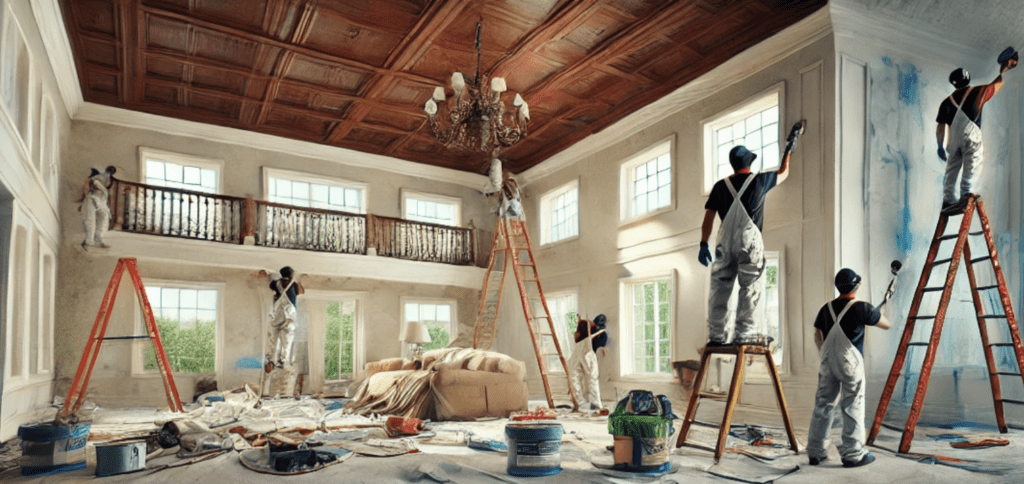Effective leadership is crucial in the painting industry, where the quality of work and efficiency directly impact your business’s reputation and profitability. Managing a painting crew requires a combination of strong leadership skills, clear communication, and the ability to motivate your team. This comprehensive guide provides essential tips, along with explanations of why these strategies are important and how they benefit both you and your crew.
Table of Contents
- Understanding Your Role as a Crew Manager
- Effective Communication Techniques
- Delegation Strategies
- Motivating Your Painting Crew
- Training and Development
- Establishing Clear Expectations
- Ensuring Safety on the Job Site
- Conflict Resolution
- Performance Evaluation and Feedback
- Utilizing Technology for Crew Management
- Conclusion
- FAQs
Understanding Your Role as a Crew Manager

As the leader of your painting crew, your role extends beyond assigning tasks. Managing a painting crew involves:
- Leadership: Setting the vision, standards, and culture for your team. Effective leadership inspires your crew to work towards common goals, enhancing productivity and job satisfaction.
- Organization: Planning schedules, resources, and workflows efficiently ensures projects are completed on time and within budget, leading to satisfied clients and repeat business.
- Mentorship: Guiding and developing your crew members’ skills not only improves the quality of work but also boosts morale and reduces turnover.
- Problem-Solving: Addressing challenges promptly keeps projects on track, minimizes delays, and demonstrates reliability to clients.
By embracing these responsibilities, you create a productive environment where your crew can thrive, which ultimately benefits your business’s growth and reputation.
Effective Communication Techniques When Managing a Painting Crew
Clear and consistent communication is vital when managing a painting crew. It ensures everyone understands their roles, responsibilities, and project goals, reducing misunderstandings and errors.
Establish Open Lines of Communication
- Regular Meetings: Hold daily briefings to discuss project progress, address concerns, and plan the day’s tasks. This keeps everyone informed and aligned.
- Active Listening: Encourage crew members to share ideas and feedback. Valuing their input fosters a sense of ownership and can lead to innovative solutions.
- Transparent Policies: Make sure all team members are aware of company policies, safety procedures, and expectations. Clarity prevents confusion and ensures compliance.
Benefits:
- Enhances teamwork and collaboration.
- Builds trust between you and your crew.
- Improves efficiency by preventing miscommunication.
Utilize Clear Instructions

- Detailed Briefings: Provide specific instructions for each task, including materials needed and quality standards. This ensures work is done correctly the first time.
- Visual Aids: Use diagrams, samples, or mock-ups to illustrate complex tasks or desired outcomes. Visuals can clarify expectations and reduce mistakes.
- Language Considerations: Be mindful of language barriers. Using simple, direct language and checking for understanding can prevent errors due to misinterpretation.
Benefits:
- Reduces rework and associated costs.
- Increases crew confidence in performing tasks.
- Enhances overall project quality.
Delegation Strategies for Managing a Painting Crew
Effective delegation is crucial for maximizing productivity and empowering your team. It allows you to focus on higher-level management tasks while ensuring work progresses smoothly.
Assign Tasks Based on Skills and Experience
- Assess Strengths: Identify each crew member’s strengths and assign tasks that align with their abilities. This leads to higher quality work and job satisfaction.
- Promote Skill Development: Give opportunities for team members to learn new skills under supervision. Cross-training increases flexibility and reduces dependency on specific individuals.
- Balance Workloads: Ensure tasks are distributed evenly to prevent burnout and maintain morale. Fairness in task allocation fosters a positive work environment.
Benefits:
- Enhances efficiency and productivity.
- Develops a more versatile crew.
- Improves employee retention by providing growth opportunities.
Trust Your Team
- Avoid Micromanagement: Give crew members autonomy to complete tasks without constant oversight. Trusting your team boosts their confidence and accountability.
- Set Checkpoints: Establish milestones to monitor progress without hovering. Regular check-ins keep projects on track and allow for adjustments if needed.
- Provide Resources: Ensure your team has the tools and information they need to succeed. Proper resources reduce frustration and enable high-quality work.
Benefits:
- Frees up your time to focus on strategic planning.
- Encourages initiative and problem-solving among crew members.
- Builds a culture of responsibility and professionalism.
Motivating Your Painting Crew
A motivated crew is more productive, produces higher-quality work, and contributes to a positive work environment. Motivation leads to increased job satisfaction and lower turnover rates.
Recognize and Reward Excellence

- Verbal Praise: Acknowledge good work promptly and publicly. Recognition boosts morale and encourages continued high performance.
- Incentive Programs: Implement rewards for meeting goals, such as bonuses, gift cards, or extra time off. Incentives can drive productivity and commitment.
- Career Advancement: Offer opportunities for promotions or additional responsibilities. Clear pathways for growth motivate employees to excel.
Benefits:
- Enhances employee engagement and loyalty.
- Attracts top talent who seek career development.
- Improves overall team performance.
Foster Team Spirit
- Team Building Activities: Organize events or outings to strengthen relationships among crew members. A cohesive team works better together.
- Inclusive Culture: Encourage collaboration and respect within the team. Inclusivity leads to diverse ideas and solutions.
- Address Issues Quickly: Tackle any negativity or conflicts before they affect team dynamics. A harmonious work environment is essential for productivity.
Benefits:
- Increases collaboration and efficiency.
- Reduces conflicts and misunderstandings.
- Creates a supportive atmosphere that benefits everyone.
Training and Development for Managing a Painting Crew
Investing in your crew’s professional growth benefits both the individuals and your business. Well-trained employees perform better, adapt to new technologies, and contribute innovative ideas.
Provide Ongoing Training
- Skill Workshops: Offer training sessions on new techniques, equipment, or safety practices. Continuous learning keeps skills sharp and up-to-date.
- Certifications: Support crew members in obtaining relevant certifications or licenses. Certified employees can enhance your company’s credibility.
- Mentorship Programs: Pair less experienced workers with seasoned professionals for hands-on learning. Mentorship accelerates skill development.
Benefits:
- Improves work quality and efficiency.
- Prepares your team for future challenges.
- Increases employee satisfaction and retention.
Encourage Continuous Learning
- Resource Library: Supply access to industry publications, online courses, or instructional videos. Resources empower employees to learn at their own pace.
- Feedback Loop: Create an environment where crew members feel comfortable seeking guidance or clarification. Open communication fosters growth.
Benefits:
- Keeps your team informed about industry trends.
- Enhances problem-solving abilities.
- Fosters a culture of innovation and excellence.
For more on enhancing your crew’s productivity, read our article on Maximizing Productivity in Your Painting Crew: Tips and Tools.
Establishing Clear Expectations
Setting clear expectations helps prevent misunderstandings and ensures that everyone is working towards the same goals. Clarity in expectations leads to consistent results and satisfied clients.

Define Project Goals
- Detailed Plans: Share the project’s scope, timelines, and quality standards with your crew. Knowing the big picture helps everyone understand their role.
- Milestones: Break down the project into manageable phases with specific targets. Milestones enable tracking progress and maintaining momentum.
- Accountability: Assign responsibility for tasks and hold individuals accountable for their completion. Accountability ensures tasks are completed efficiently.
Benefits:
- Aligns the team towards common objectives.
- Facilitates better time management.
- Enhances client satisfaction through timely project delivery.
Create Standard Operating Procedures (SOPs)
- Consistency: Develop SOPs for common tasks to ensure uniformity in work quality. Consistency builds your brand’s reputation for reliability.
- Accessibility: Make SOPs easily accessible to all crew members, such as in a shared binder or digital platform. Easy access ensures adherence.
- Regular Updates: Review and update procedures as needed to reflect best practices. Keeping SOPs current maintains high standards.
Benefits:
- Reduces errors and rework.
- Streamlines training for new employees.
- Enhances efficiency and productivity.
Ensuring Safety on the Job Site for Managing a Painting Crew
Safety is a paramount concern when managing a painting crew. Prioritizing safety protects your team, reduces downtime due to accidents, and can lower insurance costs.
Implement Safety Protocols
- Protective Equipment: Require the use of personal protective equipment (PPE) like gloves, masks, and harnesses. PPE minimizes the risk of injuries.
- Safety Training: Conduct regular training on equipment use, hazard recognition, and emergency procedures. Training ensures everyone knows how to work safely.
- Compliance: Ensure adherence to Occupational Safety and Health Administration (OSHA) regulations and other relevant laws. Compliance avoids legal issues and fines.
Benefits:
- Protects employees from harm.
- Reduces costs associated with workplace accidents.
- Enhances your company’s reputation for professionalism.
Regular Safety Inspections
- Site Assessments: Perform routine checks of the job site to identify and address potential hazards. Proactive measures prevent accidents.
- Equipment Maintenance: Keep tools and machinery in good working order to prevent malfunctions. Well-maintained equipment is safer and more efficient.
- Incident Reporting: Establish a system for reporting and investigating accidents or near-misses. Learning from incidents improves safety practices.
Benefits:
- Promotes a culture of safety awareness.
- Minimizes project delays due to accidents.
- Builds trust with clients who value safety.
For detailed safety practices, refer to our article on Safety First: Essential Safety Practices for Protecting Your Painting Crew.
Conflict Resolution
Conflicts can arise in any team setting. Effective conflict resolution maintains harmony and productivity within your crew, preventing disruptions to workflow.
Address Issues Promptly

- Private Discussions: Speak with involved parties individually to understand their perspectives. This approach shows respect and maintains confidentiality.
- Mediation: Facilitate a meeting between conflicting parties to reach a mutual agreement. Mediation encourages open dialogue and compromise.
- Follow-Up: Monitor the situation to ensure the conflict is fully resolved. Ongoing attention prevents issues from resurfacing.
Benefits:
- Maintains a positive work environment.
- Reduces stress and tension among crew members.
- Ensures continuous productivity.
Establish a Positive Work Environment
- Zero Tolerance Policy: Enforce policies against harassment, discrimination, and unprofessional behavior. A safe workplace is essential for employee well-being.
- Open Communication: Encourage crew members to voice concerns without fear of retaliation. Transparency builds trust.
- Lead by Example: Demonstrate respectful and professional behavior in all interactions. Your conduct sets the standard for the team.
Benefits:
- Enhances team cohesion.
- Attracts and retains quality employees.
- Improves overall job satisfaction.
Performance Evaluation and Feedback
Regular evaluations help your crew understand their strengths and areas for improvement. Constructive feedback drives personal growth and improves team performance.
Conduct Formal Reviews
- Scheduled Evaluations: Hold performance reviews at consistent intervals (e.g., quarterly or annually). Regular reviews keep progress on track.
- Objective Criteria: Use measurable metrics like punctuality, quality of work, and adherence to procedures. Objectivity ensures fairness.
- Documentation: Keep records of evaluations for future reference and goal setting. Documentation supports decisions related to promotions or disciplinary actions.
Benefits:
- Provides clear benchmarks for performance.
- Identifies training needs.
- Encourages continuous improvement.
Provide Constructive Feedback

- Balanced Approach: Highlight both positive contributions and areas needing improvement. Balanced feedback motivates and guides employees.
- Actionable Advice: Offer specific suggestions on how crew members can enhance their performance. Clear guidance helps employees take meaningful steps.
- Set Goals: Collaborate with crew members to set achievable objectives for the next review period. Goal setting fosters engagement and accountability.
Benefits:
- Strengthens employee-manager relationships.
- Enhances individual performance.
- Contributes to overall team success.
Utilizing Technology for Managing a Painting Crew
Modern tools can streamline many aspects of managing a painting crew, improving efficiency and communication. They can also increase estimating efficiency and accuracy, such as PaintScout. [Check out the offer]
Project Management Software
- Scheduling: Use software to assign tasks, set deadlines, and track progress. Centralized scheduling prevents conflicts and overlaps.
- Communication: Centralize messages, updates, and files in one accessible platform. Efficient communication reduces delays and misunderstandings.
- Documentation: Keep digital records of work orders, contracts, and client communications. Organized records facilitate quick access and retrieval.
Benefits:
- Saves time and reduces administrative workload.
- Enhances collaboration among team members.
- Improves project transparency and accountability.
Mobile Applications
- Time Tracking: Implement apps for crew members to log hours worked, simplifying payroll processing. Accurate tracking ensures fair compensation.
- On-Site Reporting: Allow crew members to report issues or update progress from the job site. Real-time updates enable prompt decision-making.
- Training Resources: Provide access to instructional videos or manuals on mobile devices. On-the-go learning supports skill development.
Benefits:
- Increases operational efficiency.
- Enhances flexibility and responsiveness.
- Supports continuous improvement.
For recommendations on useful tools, visit our article on Implementing Technology in Your Painting Business: Top Software and Tools for Efficiency.
Managing a painting crew effectively is a multifaceted responsibility that requires strong leadership, clear communication, and a commitment to your team’s development. By implementing these strategies, you not only enhance your crew’s performance but also improve job satisfaction and retention. A well-managed crew delivers higher-quality work, leading to satisfied clients and a stellar reputation for your business.
Remember, investing time and resources in your team pays off through increased productivity, better project outcomes, and sustainable business growth.
FAQs
1. How can I improve communication within my painting crew?
Establish regular meetings, encourage open dialogue, and use clear, direct language. Utilize communication tools like group messaging apps to keep everyone informed. Clear communication reduces misunderstandings and fosters a collaborative environment.
2. What are effective ways to motivate my crew?
Recognize achievements, provide incentives, offer opportunities for advancement, and create a positive work environment that values each team member. Motivated employees are more productive and committed to their work.
3. How do I handle conflicts among crew members?
Address issues promptly through private discussions and mediation. Establish clear policies and lead by example to promote a respectful workplace. Effective conflict resolution maintains team harmony and productivity.
4. What technology can assist in managing a painting crew?
Project management software and mobile apps can help with scheduling, communication, time tracking, and access to training resources. Technology streamlines operations and improves efficiency.
5. Why is ongoing training important for my crew?
Continuous training enhances your crew’s skills, keeps them updated on industry best practices, and improves overall job performance and safety. Investing in training leads to higher-quality work and employee satisfaction.
For personalized assistance and more insights on managing your painting crew effectively, visit our Business Consulting Services. We’re here to help you achieve your business goals.
Ready to Lead Your Painting Crew to Success?
Implement these strategies on managing a painting crew and watch your team’s productivity and job satisfaction soar. Effective leadership is the key to a thriving painting business.
👉 Enhance Your Leadership Skills with Our House Painting Business Training

Pingback: How to Scale Your Painting Business